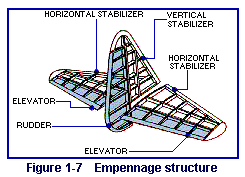 |
|||||
| Home | Research | For Teachers | HISTORY Level 1 Level 2 Level 3 |
PRINCIPLES Level 1 Level 2 Level 3 |
CAREER Level 1 Level 2 Level 3 |
| Gallery | Hot Links | What's New! | |||
| Web Administration and Tools | |||||
 |
|||||
| Home | Research | For Teachers | HISTORY Level 1 Level 2 Level 3 |
PRINCIPLES Level 1 Level 2 Level 3 |
CAREER Level 1 Level 2 Level 3 |
| Gallery | Hot Links | What's New! | |||
| Web Administration and Tools | |||||
![]()
The empennage, commonly called the tail assembly (see figure 1-7), is the rear section of the body of the airplane. Its main purpose is to give stability to the aircraft. The fixed parts are the horizontal stabilizer and the vertical stabilizer or fin.
 The front, fixed section is called the horizontal stabilizer and is
used to prevent the airplane from pitching up or down.
The front, fixed section is called the horizontal stabilizer and is
used to prevent the airplane from pitching up or down.
The rear section is called the elevator and is usually hinged to the horizontal stabilizer. The elevator is a movable airfoil that controls the up-and-down motion of the aircraft's nose.
The vertical tail structure is divided into the vertical stabilizer and the rudder. The front section is called the vertical stabilizer and is used to prevent the aircraft from yawing back and forth. The principle behind its operation is much like the principle of a deep keel on a sailboat. In light, single-engine aircraft, it also serves to offset the tendency of the aircraft to roll in the opposite direction in which the propeller is rotating.
The rear section of the vertical structure is the rudder. It is a movable airfoil that is used to turn the aircraft.
Send all comments to ![]() aeromaster@eng.fiu.edu
aeromaster@eng.fiu.edu
© 1995-98 ALLSTAR Network. All rights reserved worldwide.
| Funded in part by | From Civil Air Patrol Educational Materials |
Updated: February 17, 1999